Staggering levels of raptor persecution (the illegal persecution of birds of prey) have been in the news again following both the release of the RSPB’s Birdcrime report for 2022 and the Scottish Parliament voting on November 30th to support the general principles of the Wildlife Management & Muirburn Bill. The Bill includes measures to introduce a licensing scheme for grouse moors and was largely introduced because of appalling inaction by the grouse shooting industry to curb raptor persecution.
The ‘Muirburn Bill’ in particular has been welcomed as a way of tackling wildlife crime. Protect the Wild would of course welcome a crack-down on the illegal killing of birds of prey, but we don’t think licencing shooting wild birds is the way it will happen.
Hen Harrier. Image shutterstock
Hen Harriers and grouse moors
In Birdcrime 2022, the RSPB reported that “there were 61 confirmed bird of prey persecution incidents, and at least 64% of these were linked to land used for gamebird shooting“, in other words directly linked to the shooting industry. The charity went on to say “These figures only show the confirmed incidents – the actual figures are likely to be much higher– as crimes often take place in remote areas where the perpetrators can easily conceal these activities.” In other words, on grouse moors.
Hen Harriers, a moorland breeding species loathed by shooting estates because they take small numbers of grouse chicks, have been especially and ruthlessly targeted. Many young harriers have been satellite-tagged enabling researchers to track their movements. The RSPB says that Hen Harriers are ten times more likely to die on grouse moors than anywhere else, and that:
“Between January 2022 and October 2023, data from the RSPB and Natural England shows that 39 Hen Harriers have been confirmed killed, or ‘suspiciously disappeared’ across the UK. A recent peer-reviewed study published by RSPB Centre for Conservation Science and using a large dataset showed that the survival of tagged Hen Harriers in the UK is very low, and as much as 75% of annual mortality of tagged birds is due to illegal killing associated with grouse moor management.“
One incident is one too many, but here we are being told that THIRTY-NINE Hen Harriers have been killed or ‘mysteriously disappeared’ (which is code for killed but the evidence has not been found yet) in just 22 months!
It was less than six months ago, remember, that the RSPB released the following graphic based on the unequivocal response by Beccy Speight, the charity’s chief-executive, to the news that three Hen Harriers had been killed within days of the ‘Inglorious 12th’ (the start of the 121-day blood-soaked season the industry uses to sell as many Red Grouse as possible to its complicit clientele).
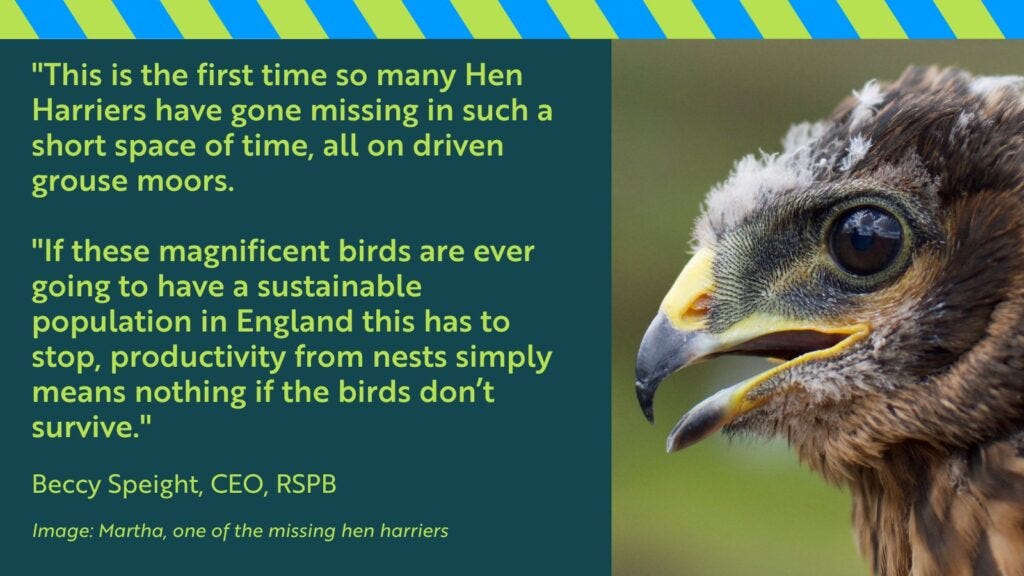
Raptor persecution is rampant, so what can be done?
Populations of birds like Hen Harriers and Golden Eagles are still recovering from decades of persecution by gamekeepers and shooting estates. They are being ruthlessly suppressed by the shooting industry.
It is without doubt a major step forward that no one now seriously doubts that grouse shooting is responsible for much of the UK’s raptor persecution (see the Google Alert below for the spread of media that highlighted the Birdcrime report), but that doesn’t tackle the question of what can be done to stop it.

Licencing
From what we understand, licencing grouse moors would, apparently, involve a shoot obtaining an operational licence from a regulator which would, at minimum, have conditions attached mandating the shoot follows wildlife and environmental protection codes of practice and laws. Where there is evidence suggesting that a shoot has failed to follow those conditions the licence can be withdrawn, even if the evidence pointing to criminality is less than sufficient to merit criminal proceedings.
We fundamentally disagree with licencing, here’s why:
Raptor persecution
Will licencing stop raptor persecution? Why would it: all birds of prey have legal protection already (see our Protectors of the Wild page Birds of Prey and the Law). The law is routinely broken because shoots won’t tolerate birds of prey on ‘their’ land because of the impact on profits. Illegal persecution is part of the business model of shooting. And as far as shoots are concerned, laws protecting birds of prey are largely unenforceable anyway. As the RSPB points out, many crimes take place in remote areas far from public view. Licencing doesn’t change that. Raptors will still be killed whenever shoots can get away with it.
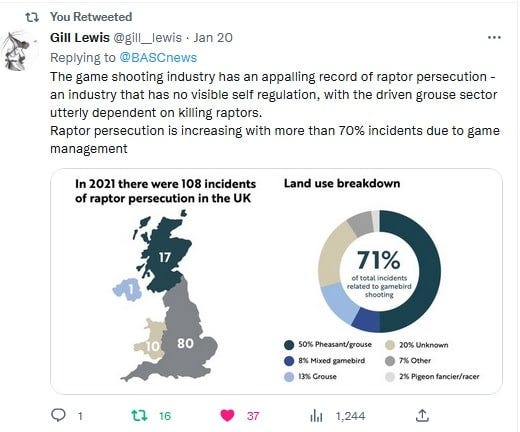
Licencing actually further enables the slaughter of birds and mammals
Licencing does nothing to address the fact that hundreds of thousands of Red Grouse are killed for ‘sport’ every year. As the climate warms, shoots are increasingly introducing pheasants to parts of the highlands and killing them too.
These are live birds used as targets for fun. Licencing accepts or implies that what is clearly ethically and morally unacceptable is somehow okay. It is not.
Legal predator ‘control’
Because current law says they can be, countless thousands of wild animals (including foxes, mustelids (weasels and stoats), and corvids (crows) are ‘legally’ shot, trapped, or snared every year to protect industry profits. An estimated 260,000 wild animals are killed every year on Scotland’s grouse moors alone, and a recent report ‘Killing to KIll’ by the Oxford Centre for Animal Ethics graphically details how ‘control’ methods cause suffering, or prolong suffering, or make animals liable to suffering.
Legislation favours the shooting industry so while snares are gradually being outlawed (despite fierce industry lobbying to keep them), restrictions on firearms are not being tightened and the use of traps is widespread. Records are not kept and data on population levels of these animals is not held.
Licencing implies that the enormous slaughter of wild animals for this non-essential hobby is somehow okay. Again it is not.
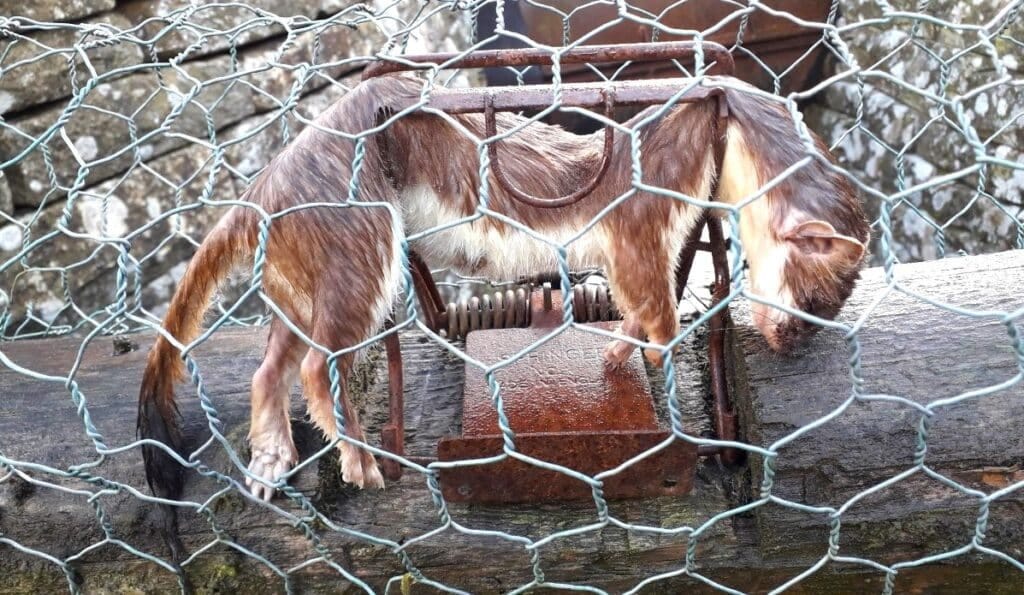
Both sides have to want this to work – they don’t.
Whilst the vast majority of us will never think that killing birds of prey and running shoots where thousands of birds are simply bred to be shot is acceptable, the industry as a whole remains convinced it is doing nothing wrong – either legally or morally. Their attitude is that moorland is meant to be shot over, birds like grouse are fun to shoot at, and the rest of us with our ‘woke’ complaints can get lost. They don’t accept that any form of licencing is valid or necessary, and while they make the right noises about ‘zero tolerance’ of raptor persecution, the reality on the ground tells a completely different story. Until they accept that they are in the wrong, nothing will change.
Denial
Many industry lobbyists are still in denial that raptor persecution even takes place or work to spin the terrible figures positively (see the Google Alert below which shows how the same news is reported). They routinely ignore the fact that ‘hatching’ is not the same as ‘surviving to adulthood’. Bragging about the number of chicks that fledge is a smokescreen used to hide the fact that in far too many cases once raptors leave the safety of the nest (which is often monitored closely by conservationists and government scientists) they are hunted down and killed.
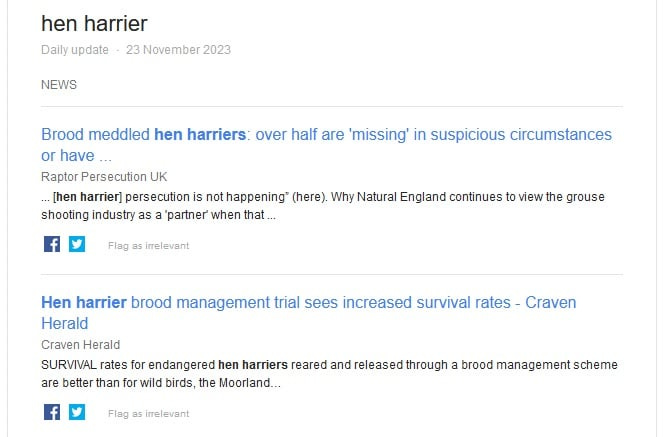
Partnership
Many ‘spokespeople’ for shooting like Ian Botham are relentlessly critical of conservation organisations, but for licencing to work, conservationists, enforcing authorities, and the shooting industry must agree to make it work together. But as we say above shooting doesn’t want ‘licencing’ – in fact, like fox hunters before them, they don’t want any form of control at all. Just like fox hunters they will be uncooperative and will work to exploit any exemptions (and any biases). And they certainly can’t see themselves in any sort of ‘partnership’ with the organisations or individuals that do want it.
Hoping that estate owners and gamekeepers will just accept, self-enforce, and work with conservationists on any licencing conditions pushed upon them – regardless of unenforceable and vague threats to sanction them by withdrawing those licences – is pie-in-the-sky thinking.
Enforcement
That might seem a compelling argument at first, but there are huge differences at play here. Firstly, while there are still chancers out on the road and avoidable deaths are still occurring, most of us fully accept now that speeding kills people and that wearing a seat belt saves lives (especially our own). There is plenty of self-interest involved. And we know, secondly, that the chances of getting caught breaking the law while nowhere near 100% are at least high enough to dissuade criminal behaviour in many cases and for us to routinely now ‘clunk click before every trip’. There is enforcement on the roads.
As we’ve already said, though, far too many estates think that licencing is an affront to their interests and will never accept otherwise. Saving the lives of a few birds of prey when they may take grouse or pheasant chicks makes no sense to them. And what difference will licencing make to lawbreakers being caught? There are very few police forces determined to crack down on raptor persecution. There are virtually no cameras (except on some nest sites). The only patrol cars are owned by the gamekeepers themselves. Without a massive increase in funding for proper investigation of estates and firm law enforcement (and we’ve not seen reports to suggest this is at all likely) plus the willingness of estate owners to report the criminals in their midst (ditto), what difference will licencing make?
Will a few estates slip up and get caught? Possibly, but very few estates have ever been ‘punished’ for wildlife crimes by losing their general licences (a handful) or been charged with vicarious liability (even fewer). There has been just ONE conviction for raptor persecution in Scotland – ever. It is incredibly hard to win cases in court. Estates can afford defence lawyers that gleefully exploit exemptions in laws that are either poorly written or deliberately hobbled by lobbyists within Parliament itself. Call us cynical, but do we really have any faith that any estate will simply say ‘You got me, take away my licence’? Of course not. They will tie up the courts for years and in the meantime birds and mammals will continue to die.
Without proper enforcement, licencing will be a change on paper only.
Licencing means never shutting down grouse moors

A licencing lifeline is not the answer
Grouse shooting is a non-essential, unethical anachronism with few supporters. Without any firm guarantees on a change of attitude, proper enforcement, and a willingness to make licencing work, nothing will change and raptor persecution will continue.
Even if – and it is a huge if – licencing somehow deters raptor persecution, the immoral killing of millions of birds and mammals will carry on. Huge areas of land will still be ringfenced and ‘managed’ for a few armed hobbyists (at a time, note, that even shooting estates acknowledge there is more money to be made from carbon storage or carbon offsetting than killing birds).
As far as Protect the Wild is concerned, handing grouse shooting a ‘licencing lifeline’ makes absolutely no sense whatsoever.
(Header image. A Short-eared Owl shot on a grouse moor. Image South Yorkshire Police)

- For more information on recognising and reporting raptor persecution see our Protectors of the Wild page Birds of Prey and the Law

